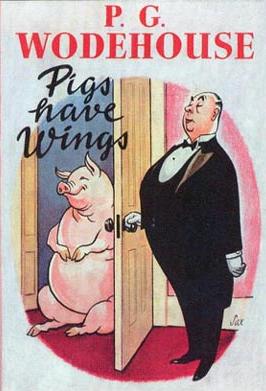Pigs Have Wings
by
P. G. Wodehouse
Literary and Cultural References
This is part of an ongoing effort by the members of the Blandings Yahoo! Group to document references, allusions, quotations, etc. in the works of P. G. Wodehouse. These notes are by Neil Midkiff, with contributions from others as noted below.

 Pigs Have Wings was first published in the US by Doubleday & Co. on 16 October 1952, and appeared in the UK published by Herbert Jenkins Ltd. on 31 October 1952. It appeared in serial form in the US magazine Collier’s from 16 August 1952 through 20 September 1952. See this page for notes on some differences between the serial and the text of the books.
Pigs Have Wings was first published in the US by Doubleday & Co. on 16 October 1952, and appeared in the UK published by Herbert Jenkins Ltd. on 31 October 1952. It appeared in serial form in the US magazine Collier’s from 16 August 1952 through 20 September 1952. See this page for notes on some differences between the serial and the text of the books.
|
Chapter 1 Chapter 2 Chapter 3 Chapter 4 Chapter 5 Chapter 6 Chapter 7 Chapter 8 Chapter 9 Chapter 10 Chapter 11 |
One
Beach … Lord Emsworth
We meet these characters in the first novel of the Blandings saga, Something Fresh/Something New (1915).
young under-footman
A young man might enter this level of service once he reached his full height, in his middle or late teens, so Beach may well be in his later forties.
thirty years ago
In “Lord Emsworth Acts for the Best” (1926) we learn that Beach entered Lord Emsworth’s service eighteen years ago as an under-footman.
salver
See Leave It to Psmith.
afternoon post
Even a country house outside a small market town received multiple mail deliveries each day in that era. See Money for Nothing.
Whiffle on The Care of the Pig
See Uncle Fred in the Springtime.
Lady Constance Keeble
Lady Constance, one of Lord Emsworth’s ten sisters, is introduced in Leave It to Psmith (1923), and serves as chatelaine of Blandings Castle in six novels and several short stories, since Lord Emsworth is a widower.
Sir Gregory Parsloe
The closest neighbor to Blandings Castle, a baronet, in full Sir Gregory Parsloe-Parsloe, of Matchingham Hall. First met in “The Custody of the Pumpkin” (1924 in magazines; collected in Blandings Castle and Elsewhere, 1935). In his youth he had been a close acquaintance of the Hon. Galahad Threepwood, Lord Emsworth’s younger brother.
Bart
The conventional abbreviation for Baronet. A baronetcy is effectively a hereditary knighthood; a married baronet and his wife would be addressed as Sir John and Lady Jane, but their rank is below those of the peerage, so he is not a Lord.
an Earl
An Earl is a member of the British peerage, ranking below a marquess and above a viscount; an Earl has the title “Earl of” when the title originates from a place name. [JD] Emsworth is a village on the Hampshire coast where Wodehouse lived for varying periods between 1903 and 1914.
“Whoopee!”
As an interjection signaling excitement or agreement, the term is cited in the OED with American examples beginning 1827.
“You said it, pal!”
In the sense of “I agree with you!” the OED has American citations beginning 1911 for “You said it.” Adding “pal” gives it an addition Western American flavor; Wodehouse is demonstrating his mastery of the varieties of the English language by noting how incongruous these slang terms would be in the diction of a well-trained butler.
dwelling in marble halls with vassals and serfs at his side
A well-known aria from the English opera The Bohemian Girl (1843; music by Michael Balfe, lyrics by Alfred Bunn). The lyrics begin:
I dreamt I dwelt in marble halls
With vassals and serfs at my side…
lucky stiff
A slang term for a person in fortunate circumstances, especially said in a case where the speaker would enjoy having the perquisites but perhaps not the actual position. An American term, entering the language about 1910.
charabanc
A motor-coach, here one carrying tourists to view a stately home.
half a crown
A former British coin, valued at two shillings and sixpence or one-eighth of a pound sterling. Accounting for inflation from 1952 to August 2022, the Bank of England suggests a factor of 21.62, so this would be the rough equivalent of £2.70 or US$4 in modern times.
a crumpled leaf in his bed of roses
See Sam the Sudden.
gravel soil
Empress of Blandings
A black Berkshire sow, first met in “Pig-hoo-o-o-o-ey!” (1927; collected in Blandings Castle and Elsewhere, 1935).
Twice in successive years
Her first medal is won in “Pig-hoo-o-o-o-ey!” (1927); her second win is foreshadowed at the end of Heavy Weather (1933). This is among the numerous items of evidence that the internal time scale of Wodehouse’s stories is not related to the year of publication. For more on this topic, see note 5 in the downloadable Preface to Who’s Who in Wodehouse.
Two years before
As recounted in “Company for Gertrude” (1928; collected in Blandings Castle and Elsewhere, 1935).
Dash it all
A euphemism for “Damn it all” see A Damsel in Distress.
Two
Three
Four
Five
Six
Seven
Eight
Nine
Ten
Eleven
Wodehouse’s writings are copyright © Trustees of the Wodehouse Estate in most countries;
material published prior to 1930 is in USA public domain, used here with permission of the Estate.
Our editorial commentary and other added material are copyright
© 2012–2025 www.MadamEulalie.org.